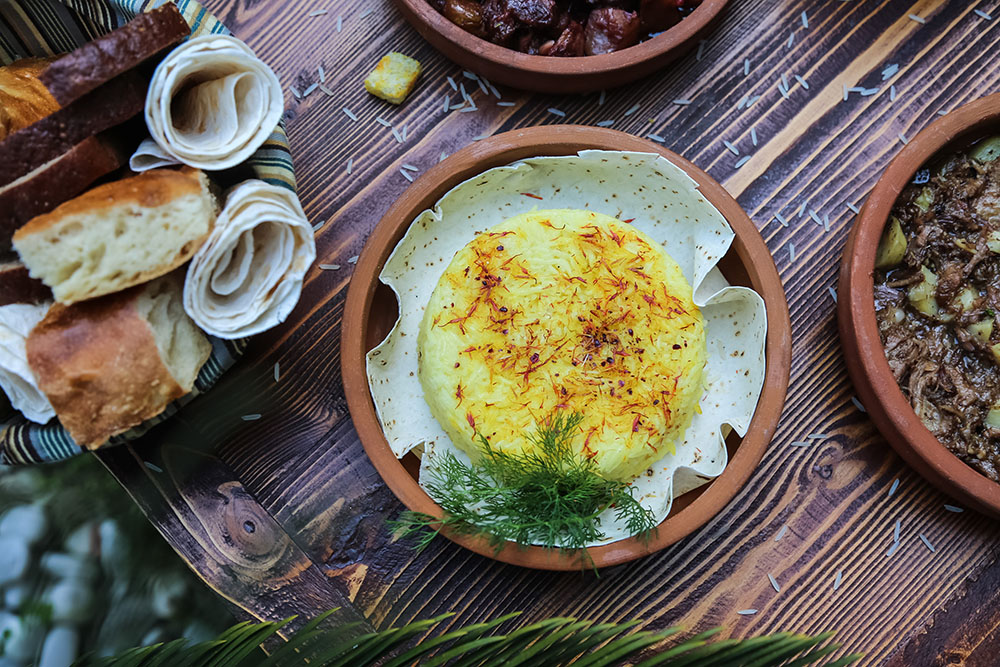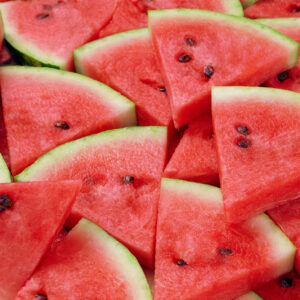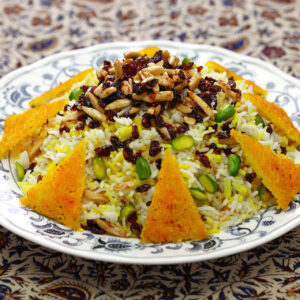Rice, or “polow” as it’s called in Farsi, is the quintessential grain of Persian cuisine. . Persian chefs have perfected the art of cooking rice, resulting in a dish that is not only delicious but also beautiful to behold.

Rice, or “polow” as it’s called in Farsi, is the quintessential grain of Persian cuisine. In fact, it’s hard to imagine a Persian meal without a steaming mound of fragrant, fluffy rice sitting in the center of the table. Persian chefs have perfected the art of cooking rice, resulting in a dish that is not only delicious but also beautiful to behold.
The process of cooking Persian rice is intricate and time-consuming, but the end result is well worth the effort. First, the rice is washed several times to remove excess starch and impurities. Then, it is soaked for several hours or overnight to help the grains cook evenly and to reduce cooking time.
The rice is then boiled in a large pot of salted water until it’s partially cooked. At this point, the rice is drained and rinsed with cold water to stop the cooking process and to remove any remaining starch.
Next, the rice is steamed to perfection. This is done by layering the partially cooked rice in a pot with oil, ghee, or butter and then topping it with saffron water, which gives the rice its distinctive golden color and delicate flavor. The pot is then covered tightly and placed over low heat to allow the rice to steam and absorb the flavors of the saffron and fat. The result is a dish of fluffy, perfectly cooked rice with a crispy, golden crust on the bottom. This crust, known as “Tahdig,” is a beloved part of Persian cuisine and is often served as a separate dish.
Tahdig is not just a byproduct of the rice cooking process but a delicacy in itself. To make Tahdig, the bottom of the pot is coated with oil, butter, or ghee before the rice is added, allowing it to cook to a crispy perfection as the rice steams. Once the rice is cooked, the pot is turned upside down to reveal the golden and crunchy Tahdig.
Tahdig is not only a delicious accompaniment to Persian rice, but it’s also a centerpiece that makes the dish a feast for the eyes and the taste buds. It’s a source of pride for Persian cooks, who strive to achieve the perfect balance of crispiness and flavor in their Tahdig. Overall, Persian rice and Tahdig are a true testament to the culinary artistry of Persian cuisine.
Polo ba Zaferoon Recipe:
- Prep Time: 5 min
- Cook Time: 50 mins
- Soaking: 1 hour
- Total Time: 1 hr 55 min
Serves: 4
Ingredients:
- 2 cups white basmati rice, soaked and rinsed
- 8 1/4 cups water, divided
- 2 tablespoons salt, for parboiling the rice and will be rinsed out.
- 4 tablespoons oil divided
- 1/4 teaspoon saffron threads, ground and mixed with 2 tablespoons water
Instructions:
- Wash the rice thoroughly and set aside to soak for at least one hour or up to 6 hours.
- In a large covered pot, bring 8 cups of water and salt to a boil. Add the rinsed rice and boil on high heat uncovered for about 5-7 minutes, or until the rice has slightly softened.
- Drain the rice in a colander and set aside while you prepare the pan.
- Add 2 tablespoons of oil to a non-stick pot.
- In a small bowl, mix 1 cup of the lightly cooked rice with 1 tablespoon of saffron-water mixture, gently mix and spread evenly in the bottom of the pot. This will be the crispy rice referred to as Tahdig.
- Pour the remainder of the rinsed rice into the pot and lightly fluff with a fork. Drizzle the remaining 2 tablespoons of oil over the top of the rice.
- Pour the additional 1/4 cup water evenly over the top of the rice. Wrap the lid with a clean towel and place it on top of the pot. This will allow the rice to steam.
- Allow the rice to steam over medium-low heat for 45 minutes.
- Pour the remaining 1 tablespoon of saffron water over the top of the rice.
- Cautiously and swiftly invert the rice out of the pot onto a large serving platter and serve immediately.
Chefs Notes: I prefer to use a non-stick pot so I can easily flip over the pot and serve the rice upside down, showcasing the crunchy saffron tahdig.
When steaming the rice, never lift the lid or mix the rice.
Related Articles

Rice, or “polow” as it’s called in Farsi, is the quintessential grain of Persian cuisine. In fact, it’s hard to imagine a Persian meal without a steaming mound of fragrant, fluffy rice sitting in the center of the table. Persian chefs have perfected the art of cooking rice, resulting in a dish that is not only delicious but also beautiful to behold.
The process of cooking Persian rice is intricate and time-consuming, but the end result is well worth the effort. First, the rice is washed several times to remove excess starch and impurities. Then, it is soaked for several hours or overnight to help the grains cook evenly and to reduce cooking time.
The rice is then boiled in a large pot of salted water until it’s partially cooked. At this point, the rice is drained and rinsed with cold water to stop the cooking process and to remove any remaining starch.
Next, the rice is steamed to perfection. This is done by layering the partially cooked rice in a pot with oil, ghee, or butter and then topping it with saffron water, which gives the rice its distinctive golden color and delicate flavor. The pot is then covered tightly and placed over low heat to allow the rice to steam and absorb the flavors of the saffron and fat. The result is a dish of fluffy, perfectly cooked rice with a crispy, golden crust on the bottom. This crust, known as “Tahdig,” is a beloved part of Persian cuisine and is often served as a separate dish.
Tahdig is not just a byproduct of the rice cooking process but a delicacy in itself. To make Tahdig, the bottom of the pot is coated with oil, butter, or ghee before the rice is added, allowing it to cook to a crispy perfection as the rice steams. Once the rice is cooked, the pot is turned upside down to reveal the golden and crunchy Tahdig.
Tahdig is not only a delicious accompaniment to Persian rice, but it’s also a centerpiece that makes the dish a feast for the eyes and the taste buds. It’s a source of pride for Persian cooks, who strive to achieve the perfect balance of crispiness and flavor in their Tahdig. Overall, Persian rice and Tahdig are a true testament to the culinary artistry of Persian cuisine.
Polo ba Zaferoon Recipe:
- Prep Time: 5 min
- Cook Time: 50 mins
- Soaking: 1 hour
- Total Time: 1 hr 55 min
Serves: 4
Ingredients:
- 2 cups white basmati rice, soaked and rinsed
- 8 1/4 cups water, divided
- 2 tablespoons salt, for parboiling the rice and will be rinsed out.
- 4 tablespoons oil divided
- 1/4 teaspoon saffron threads, ground and mixed with 2 tablespoons water
Instructions:
- Wash the rice thoroughly and set aside to soak for at least one hour or up to 6 hours.
- In a large covered pot, bring 8 cups of water and salt to a boil. Add the rinsed rice and boil on high heat uncovered for about 5-7 minutes, or until the rice has slightly softened.
- Drain the rice in a colander and set aside while you prepare the pan.
- Add 2 tablespoons of oil to a non-stick pot.
- In a small bowl, mix 1 cup of the lightly cooked rice with 1 tablespoon of saffron-water mixture, gently mix and spread evenly in the bottom of the pot. This will be the crispy rice referred to as Tahdig.
- Pour the remainder of the rinsed rice into the pot and lightly fluff with a fork. Drizzle the remaining 2 tablespoons of oil over the top of the rice.
- Pour the additional 1/4 cup water evenly over the top of the rice. Wrap the lid with a clean towel and place it on top of the pot. This will allow the rice to steam.
- Allow the rice to steam over medium-low heat for 45 minutes.
- Pour the remaining 1 tablespoon of saffron water over the top of the rice.
- Cautiously and swiftly invert the rice out of the pot onto a large serving platter and serve immediately.
Chefs Notes: I prefer to use a non-stick pot so I can easily flip over the pot and serve the rice upside down, showcasing the crunchy saffron tahdig.
When steaming the rice, never lift the lid or mix the rice.











